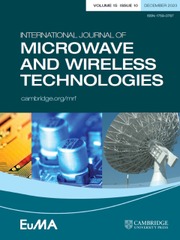No CrossRef data available.
Dual-port circularly polarized optically transparent MIMO antenna for N77/N78 5G applications
Published online by Cambridge University Press: 16 October 2025
Abstract
A work of compact dual-port transparent multiple-input multiple-output antenna optimized for fifth-generation (5G) N77 (3.3–4.2 GHz) and N78 (3.3–3.8 GHz) bandwidth has been simulated, investigated, and optimized for robust performance in high-speed wireless communication. It features an impedance bandwidth of 3–4.3 GHz with a minimum simulated return loss of −28 dB, with 100% 3-dB axial ratio bandwidth and a simulated gain of 3.5 dB. The conducting plane material is indium tin oxide (ITO), chosen for its high optical transparency and sufficient electrical conductivity to seamlessly integrate into visually demanding applications. The substrate is glass, chosen for its lightweight and durable properties, which enhance both the mechanical durability of the antenna and its electromagnetic performance. To validate the ITO-based simulated design, the prototype with the same geometrical specification has been fabricated with the conducting portion replaced with copper and substrate as glass material due to a lack of facilities for transparent antenna fabrication. The comparative investigation study between the proposed ITO-based transparent antenna and with copper-based prototype (simulated/measured) both on a glass substrate, has been discussed, which supports the findings.
Keywords
Information
- Type
- Research Paper
- Information
- International Journal of Microwave and Wireless Technologies , Volume 17 , Issue 7 , September 2025 , pp. 1228 - 1240
- Copyright
- © The Author(s), 2025. Published by Cambridge University Press in association with The European Microwave Association.


